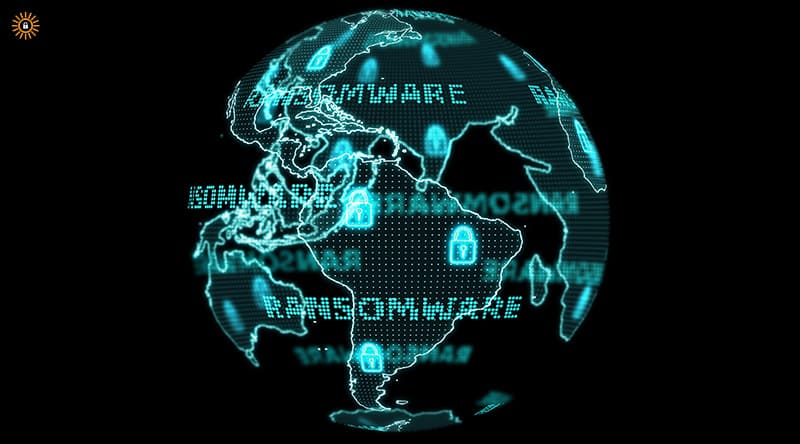- September 13, 2021
- Tags:

Ransomware is a form of malware that encrypts files or programs on a device and renders them unusable. Then, using extortion software, cybercriminals block user access to the system and demand payment for its release (cryptocurrency is the payment method of choice during ransomware attacks). Typically, a ransom demand comes with a deadline, and failure to pay often results in the stolen data being resold on the dark web or exploited for follow-up attacks.
The ransomware’s impact now affects both individuals and organizations, and the easy availability of malware kits and ransomware as a service (RaaS) fuels the threat. Although the attacks are getting more sophisticated, executing them is becoming simpler. Even those who aren’t tech-savvy can buy ransomware from the dark web and launch it.
In March 2021, CNA Financial set a record by paying $40 million to hackers after ransomware blocked its server access and stole its data. According to the 2021 Cybersecurity & Infrastructure Security Agency report, email phishing campaigns, software vulnerabilities, and Remote Desktop Protocol vulnerabilities are the most common methods hackers use to carry out ransomware attacks. In 2019, the cost of ransomware attacks in the world surpassed $7.5 billion.
Combating Ransomware: Prevention Best Practices
Ransomware attacks target businesses of all sizes—therefore, organizations must be proactive and have a cybersecurity plan should a ransomware attack occur. Ransomware proliferates due to a lack of awareness and proper training for all users. From regular data backups to the increasing system- and network-level protection, there are many steps organizations can take to prevent ransomware attacks and limit their impact.
Below are some of the prevention best practices for combating ransomware:
- Create plans and implement policies: With proper protocols in place, users can follow the necessary steps if there is any indication of a ransomware attack. Pre-defining roles and communication reduces any state of confusion. Additionally, implementing company-wide cybersecurity policies can increase cybersecurity awareness.
- Perform frequent backups: Creating a regular data backup sequence of critical data is one of the effective ways to combat ransomware attacks. However, these backups should be adequately protected and kept offline (having a hot site and a warm site is vital), beyond the reach of the attackers. In addition, cloud storage services that retain previous versions of the data can also mitigate the effects of the ransomware attack and ensure that you can recover faster from a ransomware attack without paying any ransom.
- Regularly update systems: All operating systems, software, and applications used in an organization must be updated. Latest system updates close the security gap that attackers can exploit to gain access.
- Train all team members: Cybersecurity awareness training can go a long way toward preventing ransomware attacks. When team members can spot and avoid suspicious emails and malicious attachments, they can stop attacks before they occur.
- Use a secure email gateway and good cybersecurity software: A secure email gateway device or software can monitor emails and filter out messages of spam, malware, phishing attacks, fraudulent content, and more. Cybersecurity software can also help to detect and prevent ransomware attacks.
Combating Ransomware: Detection Best Practices
Detecting a ransomware attack in its early stages can reduce the potential damage. Here are some of the best practices for detecting a ransomware attack:
- IDS System and malware detection software: Intrusion Detection System (IDS) helps identify malware in its early stages. Performing better than a traditional firewall, the IDS analyzes network traffic to detect known ransomware signatures and thus ensures network resiliency.
- Create a sacrificial deception network: The local files are the primary target of typical ransomware. Creating a sacrificial network acts as an early warning system, alerting users when these fake attack surfaces are targeted. It would also delay the acquisition of sensitive data by ransomware.
- Monitor traffic activity in the network: Understanding the network traffic activity helps detect unauthorized lateral movement and ransomware spread. Moreover, it will help to identify potential attack vectors and prevent them just in time.
- Lookout for known file extensions and increased file renames: Organizations can use the list of known ransomware file extensions to detect any suspicious activity. Another sign of a ransomware attack is a massive increase in file renames due to file encryption.
Combating Ransomware: Recovery Best Practices
As the fastest-growing cybercrime, ransomware has cost around $20 billion to the global economy this year. It threatens business environments worldwide and strikes all, irrespective of business size, type, or location.
Below are some of the best practices to follow for recovery after a ransomware attack:
- Report and seek expert guidance: In case of a ransomware attack, report to the proper authorities and get expert guidance on how to handle the situation.
- Isolate and contain affected devices: Isolating a suspected computer from other storage devices and disconnecting it from the network can help to combat the spread of ransomware. However, it is necessary to check all devices thoroughly to prevent any from slipping through the cracks.
- Implement Incident Response Plan: A proper Incident Response Plan outlines the procedures to follow after a ransomware attack and recover from it.
- Refresh and close all loopholes: After a ransomware attack, the best practice is to wipe and reinstall everything from scratch.
Conclusion
Ransomware attacks are evolving and becoming more and more sophisticated. Loss of valuable data and compromised systems can disrupt operations, thus increasing the time it takes for organizations to become functional again. Because these attacks can cause severe damage to an organization, awareness and early detection are the best chances of preventing them. However, organizations can prevent, detect, and recover from ransomware attacks with proper planning and realistic best practices.
All in all, to learn how your business can get ahead of cyberattackers that employ ransomware tactics, techniques, and procedures, then collaborating with cybersecurity experts for risk assessment and incident response is key to advancing preventive, detective, and corrective countermeasures.








